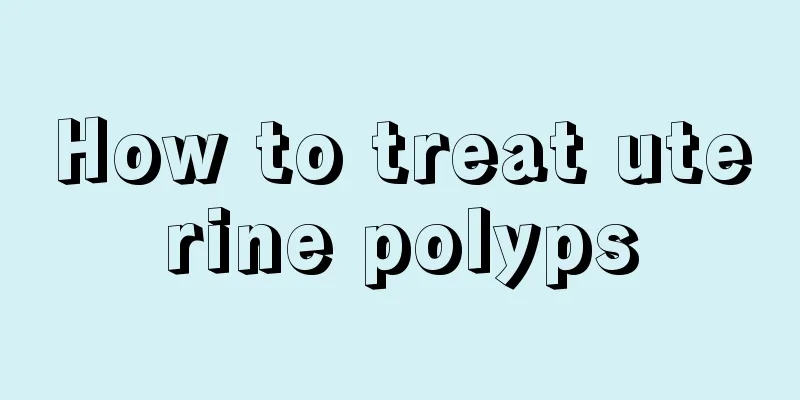How to treat uterine polyps

|
Uterine polyps are a common gynecological disease. Patients with uterine polyps would like to know how to treat uterine polyps. So, what is the best way to treat uterine polyps? Next, this article will introduce several treatment methods for uterine polyps for your reference only. Friends who want to know how to treat uterine polyps can take a look together! Please see the detailed introduction below. Uterine polyps, also known as cervical polyps, are a common gynecological disease and a type of chronic cervicitis. It is because inflammatory stimulation causes the proliferation of cervical endometrial tissue. The uterus has a tendency to expel foreign bodies, causing the proliferating mucosa to gradually protrude from the base to the external os of the cervix, forming a polyp-like change. Therefore, it is also called endocervical polyp, which is mostly benign. How to treat uterine polyps: 1. Western medicine treatment 1. Curettage is the best way to treat uterine polyps for small focal or diffuse polyps. Attention should be paid to comprehensive scraping, especially at the fundus and cornu uteri. 2. The treatment methods for endometrial polyps include: For larger polyps with pedicles, which can be seen or felt in the lower segment of the uterus, the best way to treat uterine polyps is to remove the polyps by dilating the cervix, and then perform cervical and uterine curettage to scrape out the remaining polyps and send them for pathological examination. 3. For patients with obvious bleeding symptoms, the best way to treat uterine polyps is to consider hysterectomy if the above treatment fails to eradicate the polyps or if the polyps frequently recur. This is also a treatment for endometrial polyps. 4. After intrauterine surgery, anti-infection treatment should be carried out. The best way to treat uterine polyps is to give antibiotics orally or intravenously. 5. Laser treatment of uterine polyps. The best method to treat uterine polyps is the same as laser treatment of cervical erosion. The treatment method is the same as that for cervical erosion, using a power of 40 to 60w. 6. Hysteroscopic treatment of uterine polyps. The best way to treat uterine polyps is to use 5% g,s liquid as uterine distension fluid. A bimanual examination is used to understand the position, size, shape, hardness, mobility, etc. of the uterus. 2. Chinese medicine treatment 1. Qi deficiency Symptoms: heavy menstrual blood, light red in color, clear and thin, pale face, shortness of breath and laziness to speak, empty lower abdomen, pale tongue, thin white fur, and weak pulse. Treatment method: Invigorate Qi, consolidate Chong and regulate blood. Main recipe: Juyuan Decoction with modifications. Usage and addition: If the amount of blood is heavy during menstruation, add 15g of donkey-hide gelatin, 15g of scorched wormwood leaves, 10g of roasted ginger charcoal, and 20g of cuttlefish bone to stop bleeding; if the menstrual period is prolonged, add 15g of stir-fried pollen and 20g of Kuncao to promote blood circulation and stop bleeding. 2. Dampness and heat Symptoms: heavy menstrual blood with bright red or dark red color and thick texture, or accompanied by prolonged menstruation, heavy vaginal discharge with foul odor, red tongue coating with yellow greasy coating, and stringy or slippery pulse. Treatment method: clear away heat and dampness, regulate menstruation and stop bleeding. Main prescription: Longdan Xiegan Decoction with modifications. Usage and subtraction: If the course of illness is long, blood loss is excessive, and the patient is short-tempered, lazy, tired and weak, these are signs of blood loss and damage to Qi. Add 20g of Codonopsis pilosula and 30g of Astragalus membranaceus. After the operation, the principle of TCM differentiation and treatment is adopted to promote the body's yin and yang balance. In addition, patients with a long course of illness often suffer from anemia due to excessive menstruation. Therefore, after polyp removal, they should be given drugs to nourish the spleen and qi, nourish the blood and produce blood to promote rapid recovery of the body. Commonly used medicines: ginseng (or codonopsis), astragalus, yam, atractylodes, jujube, longan meat, angelica, donkey-hide gelatin, rehmannia, white peony root, etc., for syndrome differentiation and treatment. The above is the relevant introduction about how to treat uterine polyps. Above we introduce many methods of treating uterine polyps. I believe that after reading the above introduction, you have already understood these methods. As for which method to choose to treat uterine polyps, it depends on the individual, after all, everyone's condition is different. |
<<: Is it normal for pregnant women to have cervical mucus?
>>: Exploring the causes and hazards of uneven uterine echo
Recommend
Premenstrual and early pregnancy symptoms
In life, many women are preparing for pregnancy. ...
Can I drink wine during menstruation?
There are always a few days every month that we s...
Symptoms of chronic salpingitis
The fallopian tube is an important part of female...
Ways to increase female libido
Many female friends have experienced a decrease i...
Without dieting or giving up carbs, how does a low GI diet help you lose weight? | GI Part ②
How much weight have you gained since the Mid-Aut...
What is the standard weight of a girl who is 166cm tall?
A height of 166cm is a standard height for women,...
It feels good to open packages, and it will feel good to open them as often as you like, but don’t forget to do it!
The most enjoyable thing in the world is to open ...
Can Panax notoginseng powder regulate menstruation?
Menstrual irregularities in women are still very ...
Normal range of maternal blood sugar
When a woman is pregnant, she may develop pregnan...
Picture of flat belly in six months of pregnancy
When a woman is six months pregnant, her abdomen ...
Treatment for constipation and bad breath in women
Bad breath refers to a disease in which the insid...
What are the effects of breast massage
There are many benefits of breast massage. For ex...
Rumbling stomach during menstruation
Some pregnant women will experience diarrhea duri...
Is O-type blood "universal blood"? Can it be transfused at will? Don't be fooled again...
Expert of this article: Yan Kaixin, Master of Car...
How to treat stubborn fungi
Refractory candidal vaginitis is a gynecological ...









